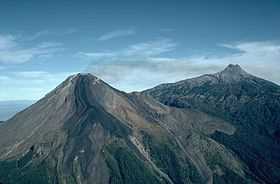Volcán de Colima
| Volcán de Colima | |
|---|---|
 Volcán de Colima is on the left with Nevado de Colima on the right | |
| Elevation | 3,839 m (12,595 ft)[1] |
| Prominence | 2,720 m (8,920 ft)[1] |
| Listing | Ultra |
| Location | |
 Volcán de Colima Location in Mexico | |
| Location | Jalisco / Colima, Mexico |
| Range | Eje Volcánico Transversal |
| Coordinates | 19°30′46″N 103°37′02″W / 19.512727°N 103.617241°WCoordinates: 19°30′46″N 103°37′02″W / 19.512727°N 103.617241°W[1] |
| Geology | |
| Type | Stratovolcano |
| Age of rock | 5 million years |
| Volcanic arc/belt | Trans-Mexican Volcanic Belt |
| Last eruption | November 2014 to April 2015 (ongoing) |


The Volcán de Colima, also known as Volcán de Fuego is part of the Colima Volcanic Complex (CVC) consisting of Volcán de Colima, Nevado de Colima (Spanish pronunciation: [ne'βado de ko'lima])[2] and the eroded "El Cantaro" (listed as extinct). It is the younger of the three and is currently one of the most active volcanos in Mexico and in North America. It has erupted more than 40 times since 1576. One of the largest eruptions was on January 20–24, 1913.[3] Nevado de Colima, also known as Tzapotépetl, lies 5 kilometres (3.1 mi) north its more active neighbor and is the taller of the two at 4,271+ meters (14,015+ ft). It is the 26th most prominent peak in North America.[4]
Despite its name, only a fraction of the volcano's surface area is in the state of Colima; the majority of its surface area lies over the border in the neighboring state of Jalisco, toward the western end of the Eje Volcánico Transversal mountain range. It is about 485 km (301 mi) west of Mexico City and 125 km (78 mi) south of Guadalajara, Jalisco.
Since 1869-1878, a parasitic set of domes, collectively known as El Volcancito, have formed on the northeast flank of the main cone of the volcano.[5]
Geological history
In the late Pleistocene era, a huge landslide occurred at the mountain, with approximately 25 km³ of debris travelling some 120 km, reaching the Pacific Ocean. An area of some 2,200 km² was covered in landslide deposits.The currently active cone is situated within a large caldera that was probably formed by a combination of landslides and large eruptions. About 300,000 people live within 40 km (25 miles) of the volcano, which makes it the most dangerous volcano in Mexico.[3] In light of its history of large eruptions and situation in a densely populated area, it was designated a Decade Volcano, singling it out for study.
.svg.png)
Current activity
In recent years there have been frequent temporary evacuations of nearby villagers due to threatening volcanic activity. Eruptions have occurred in 1991, 1998–1999 and from 2001 to the present day, with activity being characterised by extrusion of viscous lava forming a lava dome, and occasional larger explosions, forming pyroclastic flows and dusting the areas surrounding the volcano with ash and tephra.
The largest eruption for several years occurred on May 24, 2005. An ash cloud rose to over 3 km over the volcano, and satellite monitoring indicated that the cloud spread over an area extending 110 nautical miles (200 km) west of the volcano in the hours after the eruption . Pyroclastic flows travelled four-five km from the vent, and lava bombs landed 3–4 km away. Authorities set up an exclusion zone within 6.5 km of the summit.
On November 21, 2014, the volcano erupted again. An ash column was sent 5 km into the air, covering towns as far as 25 km away in ash. No fatalities were reported, and no evacuations are in place. It is believed the volcano presents no risk to the population, but the Interior Ministry will send a team to conduct an evaluation of the activity at the crater.[6] On January 10, 2015, the volcano erupted again. The volcano erupted yet again on January 21, 2015. The ash landed in towns more than 15 miles (24 km) away.[7] On 25 January 2015, the volcano erupted again, It was the latest in a string of eruptions.[8]
See also
- 4000 meter peaks of Mexico
- 4000 meter peaks of North America
- List of volcanoes in Mexico
- Mountain peaks of Mexico
- Mountain peaks of North America
- List of Ultras of Mexico
References
- Notes
- ↑ 1.0 1.1 1.2 "Volcán de Colima, Mexico". Peakbagger.com.
- ↑ "The Colima Volcanic Complex, Mexico" (PDF). Mineralogy and Petrology. Retrieved 2012-05-04.
- ↑ 3.0 3.1 Ritchie, David (2006). ENCYCLOPEDIA OF EARTHQUAKES AND VOLCANOES. ALEXANDER E. GATES, PH.D., AND DAVID RITCHIE. p. 52.
- ↑ "North America Peaks with 2000 meters of Prominence". Peakbagger.com. Retrieved 2012-05-03.
- ↑ "STRUCTURE OF THE VOLCANCITO DOME, VOLCAN FUEGO DE COLIMA, MEXICO, REVEALED IN HIGH RESOLUTION MAGNETIC ANOMALIES". confex.com.
- ↑ "Mexican Volcano of Fire spews 5km-high pillar of ash (VIDEOS)". RT.com. November 22, 2014. Retrieved November 22, 2014.
- ↑ "VIDEO: Mexico’s Colima Volcano spews enormous cloud of ash". NY Daily News.
- ↑ "Footage of huge ash plume as Mexico's Colima volcano erupts". BBC News. 25 January 2015. Retrieved 27 January 2015.
- Bibliography
- Domínguez T., Ramírez J.J., Breton M. (2003), Present Stage Of Activity At Colima Volcano, Mexico, American Geophysical Union, Fall Meeting 2003, abstract #V42B-0350
External links
- Universidad de Colima, Observatorio Vulcanológico (in Spanish)
- Universidad de Colima, Centro de Intercambio e Investigación en Vulcanología (in English and Spanish)
- Experiments at Colima by the Alaska Volcano Observatory
- "Colima". Global Volcanism Program. Smithsonian Institution. Retrieved 2009-01-14.